Breast Weight Calculator: How Much Do Your Boobs Weigh?
Ever Wondered, “How Much Do My Boobs Weigh?” You’re Not Alone.
Whether it’s curiosity, chronic back pain, or planning for a breast reduction, many women eventually ask the same question: how much do my breasts actually weigh?
The truth is, your boobs carry more than just weight—they carry impact. From posture and comfort to bra shopping and body confidence, knowing your breast weight can be surprisingly helpful.
But don’t worry—you don’t need to put them on a kitchen scale (we’ve all thought about it). This guide shares two breast weight calculators—a simple one based on your bra size, and an advanced one using your own measurements—plus pro tips for calculating volume, estimating density, and understanding the science behind it all.
Let’s get started and finally get some answers—because your boobs deserve facts, not guesses.
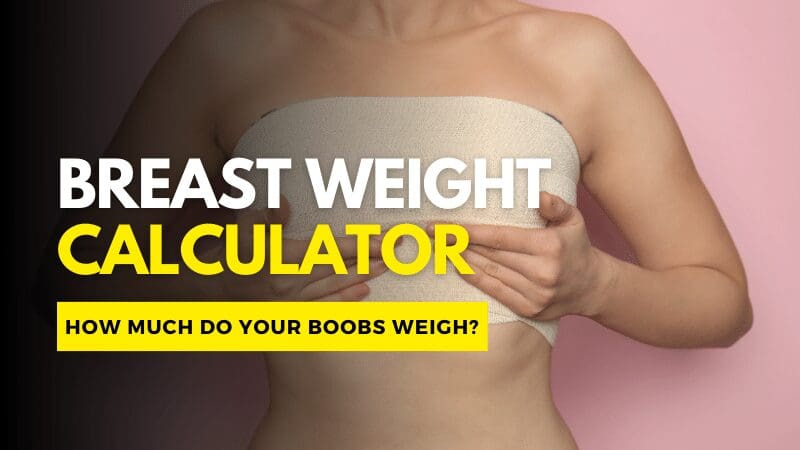
Table of Contents
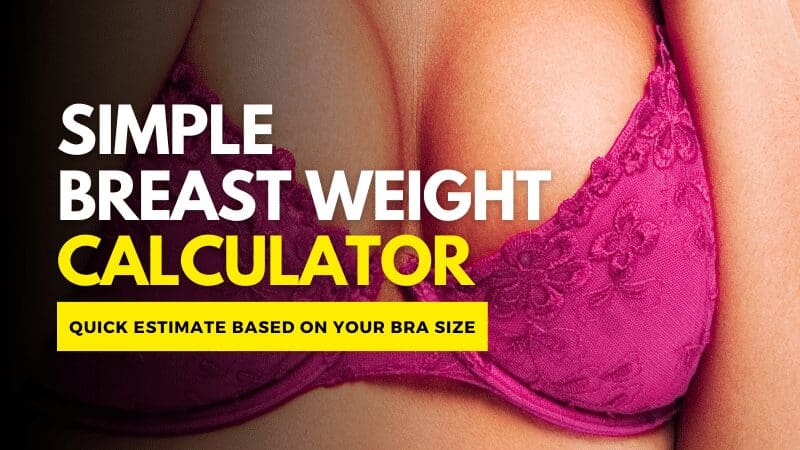
Simple Breast Weight Calculator
Note: An advanced version of this calculator is also available on this page. Please scroll to the “Advanced Breast Weight Calculator” section.
How to Use the Simple Breast Weight Calculator?
It’s surprisingly simple to find how much your breasts weigh with our simple breast weight calculator. All you need is your bra size handy.
How to Use It:
- Select your band size (e.g. 36).
- Select your cup size (e.g. DD or E).
- Get your estimate instantly.
This tool is based on a formula that calculates the volume of breast tissue and applies an average density (0.9g/cm³) to estimate weight.
📌 Note: This is an estimate, and individual results may vary based on tissue composition and body type.
Also, don’t forget to check out our Bra Size Calculator! It’s a quick and easy way to ensure you’re choosing the perfect sized and fitted bra for your body (View Top-Rated Bras on Amazon). Because when it comes to comfort and confidence, the right bra makes all the difference.
Estimated Breast Weight by Cup Size
If you’d rather get a quick idea based on your cup size, here’s a helpful reference table showing the approximate weight of breasts by band and cup size.
| Band Size | Cup Size | Avg Weight per Breast | Total Breast Weight (Both) |
|---|---|---|---|
| 32 | A | 0.3–0.4 lbs (136–181g) | 0.6–0.8 lbs (272–363g) |
| 32 | B | 0.4–0.5 lbs | 0.8–1.0 lbs |
| 34 | C | 0.8–1.0 lbs | 1.6–2.0 lbs |
| 36 | D | 1.0–1.5 lbs | 2.0–3.0 lbs |
| 38 | DD (E) | 1.5–2.0 lbs | 3.0–4.0 lbs |
| 40 | DDD (F) | 2.0–2.5 lbs | 4.0–5.0 lbs |
| 42 | G | 2.5–3.0 lbs | 5.0–6.0 lbs |
| 44 | H | 3.0–3.5 lbs | 6.0–7.0 lbs |
| 46 | I | 3.5–4.0 lbs | 7.0–8.0 lbs |
Note: This is only an estimate. Actual weight may vary depending on density, hormonal changes, and whether the breast contains more glandular vs fatty tissue.
Want a more tailored estimate? Try our advanced breast weight calculator below for a personalized result.
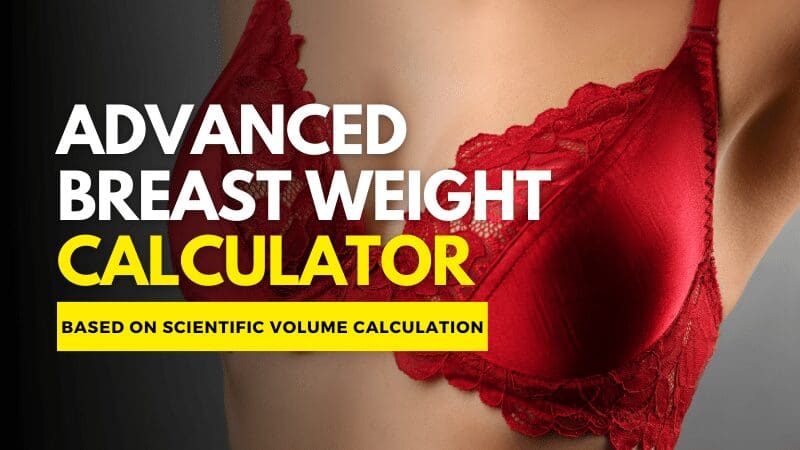
Advanced Breast Weight Calculator
A more personalized estimate using your actual breast measurements.
Left Breast Weight Calculation
Please enter your measurements accurately. Only positive values accepted. In centimeters (cms) only.
Right Breast Weight Calculation
Please enter your measurements accurately. Only positive values accepted. In centimeters (cms) only.
This calculator uses your anatomic measurements (like mammary projection and breast radius) for a more accurate estimate. Click here for our complete guide on how to calculate your breast measurements.
How to use this calculator?
- Measure your breast dimensions:
- MP (Mammary Projection): From the chest wall to the nipple
- MR (Medial Radius): From nipple to cleavage
- LR (Lateral Radius): From nipple to outer edge
- IR (Inferior Radius): From nipple down to breast base
- Enter your values into the calculator.
- Instantly receive an estimate for:
- Volume of each breast
- Total breast weight
Accurate measurements = better results. Ask someone you trust for help if needed!
How does this advanced breast weight calculator work?
The calculator uses the scientifically backed formula by Qiao et al.:
breast volume = π/3 × MP^2 × (MR + LR + IR − MP)
where,
- MP = mammary projection
- MR = medial breast radius
- LR = lateral breast radius
- IR = inferior breast radius
Then, it multiplies the volume by an estimated tissue density of 0.9 g/cm³ to calculate weight.
📌 If you know your actual breast density from a mammogram, you can input it manually for even more precise results.
How to Calculate Your Breast Volume?
There are several methods—ranging from DIY to clinical—for calculating breast volume. Below are the most common techniques, from simplest to most advanced.
| Method | How does it work? |
|---|---|
| Anatomic (Anthropometric) Measurement | Uses tape measures and calipers to measure breast dimensions. Also, the basis for our advanced breast weight calculator. |
| Archimedes (displacement of water) | Submerges the breast to measure the water displaced, equating to breast volume. |
| Imaging (mammography) | Utilizes radiographic imaging to visualize and assess breast tissue and structures. |
| Grossman-Roudner device method | Employs a mechanical device for measuring breast dimensions and assessing augmentation. |
| Casting | Involves creating a mold or cast of the breast to determine size and shape. |
| Biostereometrics | Utilizes 3D measurement techniques, including optical scanning, for precise breast measurements. |
1. Anatomic (Anthropometric) Measurement
(Basis for our advanced calculator above)
- Requires a measuring tape and a mirror.
- Measures 4 key dimensions:
- MP – Mammary Projection (chest wall to nipple)
- MR – Medial Radius (cleavage to nipple)
- LR – Lateral Radius (nipple to outer side)
- IR – Inferior Radius (nipple to base)
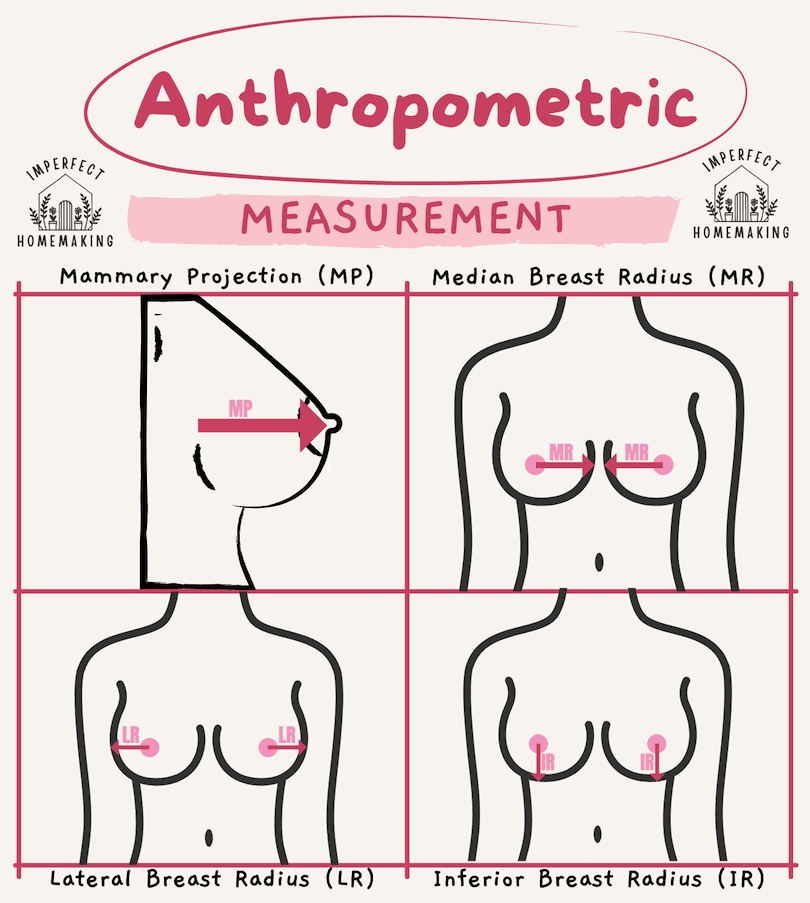
This is the most accessible and recommended method for at-home use.
Please ensure that the breasts are measured following the natural curve of your breast.
2. Water Displacement (Archimedes Method)
- Fill a container to the brim.
- Submerge the breast (carefully!) and catch overflow in a tray.
- Measure overflow volume with a measuring cup = breast volume.
💧 Very accurate but a bit messy and impractical for regular use.
3. Imaging (mammography)
- Medical-grade method using X-rays.
- Volume can be calculated from detailed internal images.
Mammography involves exposure to a small amount of radiation and is typically used for health screenings rather than casual measurement of breast volume.
In a nutshell, think of it as a high-tech way to peek inside and measure the volume of the breast with great accuracy, mostly used by healthcare professionals for very specific reasons.
4. Grossman-Roudner device method
- A specialized cup-shaped tool used in plastic surgery.
- Gently suctions over the breast and gives direct volume reading.
Used in clinical settings during augmentation or reduction consults.
5. Casting
- Mold the breast with plaster.
- Fill the mold with liquid and measure the volume.
Very precise but time-consuming and not practical for home.
6. Biostereometrics
- Uses scanners to capture 3D breast models.
- Software then calculates volume from images.
Non-invasive, highly accurate, and increasingly used in research.
Kelleigh’s Quick Tip: For most at-home users, the anthropometric method offers the best balance of ease and accuracy.
Now that we’ve got the first part done, which is the volume, let’s dive into the next step: checking your breast tissue density.
Once you know that, calculating your breast weight is a breeze. Just multiply your volume (cubic cm) by the density (per cubic cm), and you’re good to go!
How to Calculate Your Breast Tissue Density
Once you know your breast volume, the final step in calculating weight is estimating breast tissue density. Here’s how that works:
What Is Breast Tissue Density?
Breast density refers to the proportion of glandular and connective tissue (which is denser) compared to fatty tissue.
- Measured via mammograms and classified into 4 categories using the BI-RADS scale:
- Category A: Almost entirely fatty
- Category B: Scattered fibroglandular density
- Category C: Heterogeneously dense
- Category D: Extremely dense
Higher density = more glandular tissue = potentially heavier breast weight.
How to Estimate Breast Density (Without a Mammogram)
Most people don’t have access to professional imaging—so we use an average estimated density:
0.9 grams per cubic centimeter (g/cm³) is the commonly accepted value for healthy breast tissue.
This estimate allows the calculator to approximate your total breast weight when combined with your volume.
The Formula Recap
If you already know your breast volume, you can manually estimate weight like this:
Weight (grams) = Volume (cc) × Density (g/cc)
For example:
- Volume: 600 cc
- Density: 0.9 g/cc
- Weight: 600 × 0.9 = 540 grams per breast
Note: Actual density can vary based on age, genetics, hormonal factors, or conditions like fibrocystic breasts. If you have mammogram data, use your specific number for best accuracy.
Understanding Breast Weight and Health
Because your boobs aren’t just numbers—they’re part of your well-being.
Why Breast Weight Matters
Breast weight isn’t just about curiosity—it can impact your:
- Posture
- Back, neck, and shoulder pain
- Bra fit and comfort
- Daily activities like exercise or baby wearing.
Knowing your weight helps you make informed choices—whether that’s finding better support or discussing health concerns with your doctor.
Common Breast Health Factors
- Breast Composition: Made of glandular, connective, and fatty tissue—weight varies based on how much of each you have.
- Hormonal Changes: Menstrual cycles, pregnancy, breastfeeding, and menopause can all affect size and weight.
- Breast Density: Denser breasts feel firmer and weigh more.
The Right Bra Is a Game-Changer
Wearing the wrong size bra can make breast weight feel heavier than it is.
A good fit supports your chest and helps distribute weight better, reducing pressure on your back and shoulders.
Need help? Try our Bra Size Calculator or check out top-rated supportive bras [here on Amazon].
Body Image & Self-Love
Breasts come in all sizes, shapes, and weights—and they’re all beautiful.
Big, small, round, uneven—it’s all normal.
Your breast weight doesn’t define your beauty, health, or worth.
If your boobs cause discomfort or affect your self-esteem, talk to a trusted healthcare provider. You deserve to feel good in your body.
Also Read:
Quick Breast Weight Fun Facts
- The average C-cup breast weighs 1.1–1.3 pounds (500–600g).
- A pair of D-cup breasts can weigh up to 2–3 pounds or more.
- Breast weight changes with hormones, age, and body fat.
- Breastfeeding can temporarily increase breast weight by up to 35%.
- The largest natural breast size recorded was over 100 lbs!
- Back pain, shoulder dents, and posture changes are common with heavier breasts.
- The Mammary Projection (MP) and cup radius are key to measuring volume.
Breast Weight FAQs
Can breast weight cause back pain?
Yes. Heavier breasts can strain your neck, shoulders, and upper back, especially without proper bra support. This is also common for moms who carry babies for long periods.
Kelleigh’s Quick Tip: Use an ergonomic baby carrier to help distribute both your and your baby’s weight more evenly. If you’re looking for the best options, I’ve already covered them in detail—be sure to check out my guide on Best Baby Carriers and Wraps! This one is my top choice.
Can breast weight cause chest pain?
Not usually directly, but their weight can lead to chest tightness, pressure, or discomfort—especially if you’re wearing the wrong bra. A supportive, well-fitted bra can relieve a lot of these symptoms.
Can breast weight cause Cancer?
No. Breast size doesn’t affect your cancer risk. Risk is more related to genetics, hormones, and lifestyle factors.
Are bigger/larger breasts healthy?
Not at all. Breast size alone isn’t a health indicator. As long as you feel comfortable, pain-free, and confident, you’re good. Health is about how your body functions, not how it looks.
Can breast weight affect mental health or self-image?
Yes, for some people. Large breasts can cause self-consciousness, unwanted attention, or clothing limitations. But they can also boost confidence for others. How you feel matters most—don’t hesitate to seek support if body image is affecting your well-being.
Will my boobs get smaller if I lose weight?
They might. Since breasts contain fatty tissue, weight loss can reduce their size slightly—but results vary from person to person.
Do small breasts make less milk?
Nope, size doesn’t matter! Milk production depends on gland function and hormones, not breast size.
How much does an average breasts weigh?
Each breast can weigh 200–500 grams (roughly 7 to 17 oz) depending on size, composition, and body type. The calculators above can give you a more personalized estimate.
How much do D cups, DD cups, and G cups weigh?
Breast weight increases with cup size, especially when combined with larger band sizes. On average:
D cup (band 34–36): 1.5–2.0 lbs total
DD cup (band 36–38): 2.0–2.5 lbs total
G cup (band 40–44): 3.0–4.0 lbs or more
Keep in mind that breast tissue density, body type, and hormonal changes can cause variations. Our breast weight calculator can help you get a personalized estimate based on your exact size.
Do boobs get lighter after pregnancy or breastfeeding?
Yes, many women experience a reduction in breast size and weight after weaning, as milk glands shrink and fat composition may shift. However, this varies widely by body type and hormones.
Why do some people’s boobs feel heavier than others?
Breast weight is affected by tissue density, hormonal levels, genetics, and overall body fat. Two people with the same cup size can have very different weight and feel.
Conclusion
So—how much do your boobs weigh? Now you know it’s more than just a number on a scale. Whether you used the simple calculator, took precise measurements, or are just here out of curiosity—it’s all valid.
Remember, your breast weight doesn’t define your beauty, health, or worth. These tools are meant to educate, empower, and maybe even give you a little laugh if you’ve ever tried weighing yourself “before and after” on the bathroom scale (#guilty).
Big thanks to my husband Terry for helping create these calculators for his not-so-tech-savvy wife. 💻❤️
👉 Next steps:
- If you’re dealing with back pain, explore our best baby carrier and wrap guide for supportive wear options.
- If you’re concerned about your breast health, chat with your doctor.
- If you’re curious about bra fit, check out our Bra Size Calculator too!
You’re not alone in this, and knowledge is power. Own your numbers, own your body, and wear that confidence proudly.

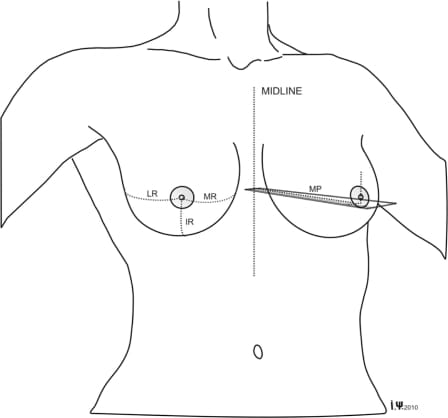






This was super informative. I’ve always wondered how much mine weighed!
Thanks so much! It’s one of those quirky questions we all think about at some point. Glad it gave you some clarity 💕
I tried both calculators and got two different results. Which one is more accurate?
Great question Jessica! The advanced calculator is usually more precise since it’s based on actual measurements. But both are great for giving you a ballpark estimate!
The calculator says my boobs weigh over 5 lbs! No wonder my back hurts 😅
Right?! It’s wild once you see the actual number. That’s a lot of weight to carry around every day—no wonder our backs need a break. A supportive bra (and good posture) really do make a difference.
It said mine were 122.09lbs, no wonder my back hurts😅 (genuinely that’s what it said somehow)